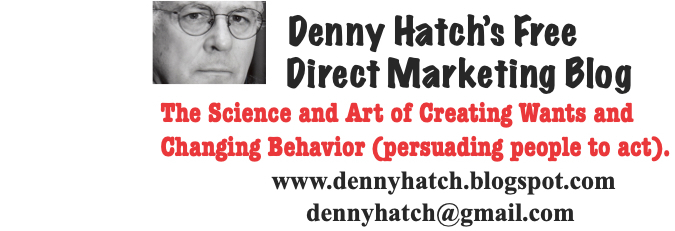#124 Blog Post - Wednesday, April 28, 2021
http://dennyhatch.blogspot.com/2021/04/124-freemiums.html
Posted by Denny Hatch
Why Direct Mail Is Such Fun:
Lumpy Envelopes and Freemiums!
When I was a kid in the 1940s, TIME magazine sent out renewal notices in a small envelope with a tiny lump at the bottom. This was a minuscule red pencil (black lead) embossed the magazine's logo.
The logic: a lumpy envelope stood out from the crowd and the dear little pencil was a convenience: no excuses for not checking the box:
"YES! Please Renew for __1 year __2 years"
I remember being fascinated by the little pencils. How did they make them so small? How did the tiny lead get into the barrel of the pencil? What was the cost to TIME magazine? How were they inserted in the envelope—by hand? By machine?
I used to treasure the pencils; took 'em to school and showed my friends.
Premiums/Freemiums
Many, many years later—when I drifted from being a traveling book salesman into managing book clubs, I had to learn all about direct mail and space advertising—the technology, the arithmetic (e.g. allowable Cost-per-Order, Offers, Pricing... all that fun stuff).
When I ran the Meredith Book clubs, we tested:
Take the New Better Homes & Gardens Fondue Cookbook FREE! and you'll receive this sturdy steel Fondue pot FREE!—yours to keep whether or not you join the club!
The arithmetic was pinned to the average number of paid books per member. Sans premiums (as I recall) the member became profitable after her fourth purchase. With the premium fondue pot she became profitable when she had paid for her sixth selection. The premium—the free goodie sent with the order—more than paid for itself when it raised response.
Same thing with the teeny TIME magazine pencil—the freemium was sent in the outgoing #9 envelope. Being lumpy, it separated itself from its stack of #10 cousins and obviously increased renewals because it was control for years.
The ACLU's Splendid Pocket Freemium
Last week Peggy received a pitch from the American Civil Liberties Union in a lumpy #10 envelope. The lump: a pocket edition of the U.S. Constitution—a very relevant and imaginative gift carried by high-powered legal scholars, politicians and patriots.
Former ACLU president Susan Herman said the first time she recalled it being brandished in public was during the Senate Watergate Hearings in 1973. The brilliant Chairman, Democrat Sam Ervin of North Carolina pulled one out of his breast pocket and startled every in the room—and millions watching on TV—when he proclaimed in his southern drawl:
"There is nothing in the Constitution that authorizes or makes it the official duty of a president to have anything to do with criminal activities."
Great Americans Never Without Their Pocket Constitutions
Left to right: Supreme Court Justices Ruth Bader Ginsberg and Stephan Breyer, the longest serving member of the Senate, Robert Byrd (D, WV) and gold star father, Khizr Kahn.
The Lede from Anthony D. Romero's Letter.
The Whole Point of the Campaign
On September 5, 1980 Candice Lightner founded Mothers Against Drunk Driving. Her 13-year-old daughter, Cari, was killed by a drunk driver. Billions of return address labels blitzed the country over the years and were affixed to the top left-hand corners of tens of millions of envelopes.
The two messages: (1) For God's sake don't drink and drive; you'll kill people. (2) If you're going out drinking, have a sober designated driver. Candice Lighners's powerful, deeply personal tragedy caught the public's imagination and the business took off. How many lives were saved as a result? It's incalculable. Probably tens of thousands.
Joe and Jane Lunchbox seeing their names and addresses on a dozen or so return address labels showing through the MADD envelope window resonated deep in their psyches. They could actually do something about drunk driving and make the world a better place!
It was also a gorgeous business model for the mailers. The whole point of the exercise was to create mailings to raise money to create more mailings to raise money... and so ad infinitum.
One could only wish someone could take on the Gun Lobby with a campaign like this! The problem: we're a country full of bloody minded gun nuts.
Takeaways to Consider
• The great direct marketing consultant, Dick Benson, proclaimed if you use a premium, it does not need to have any relationship to the offer. It's the desirability of the product that counts.
• Tote bags are obvious premiums—magazine circulation people use them all the time. After all a tote bag with the magazine's name on it is an ad for the magazine.
• However, a while back I received a real strange mailing from DOCTORS WITHOUT BOARDERS—a very fat 6"x9" cardboard envelope containing a donation pitch along with a tote bag. The Premium was the Freemium.
• My take: savvy consumers (and potential donors) could be very pissed off at DWB wasting all that money on a tote bag mailing when it could go toward healing. I cannot believe it was profitable.
• (If you received this mailing I'd sure like to know about it. It means the test was successful, was rolled out and I'm dead wrong.)
• Whereas a premium need not relate to the product or service, a freemium should relate to the contents of the mailing package (e.g., a pocket Constitution from ACLU).
• In the world of digital marketing, there ain't no freemiums and lumpy, attention-getting mailings.
• In short, next to digital marketing (and Social Media marketing), direct mail is (1) a hoot and (2) absolutely accountable.









